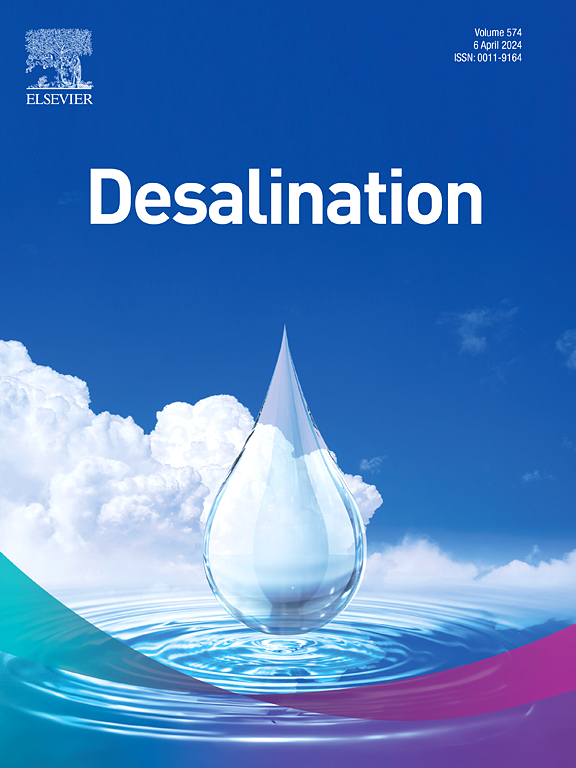Construction of two-dimensional zeolitic-imidazolate frameworks for enhanced Pb(II) and Cd(II) removal in industrial wastewater
IF 9.8
1区 工程技术
Q1 ENGINEERING, CHEMICAL
引用次数: 0
Abstract
Zeolitic imidazole-like frameworks (ZIFs) were widely used for removing heavy metal ions in industrial wastewater. However, ZIFs were featured with three-dimensional configuration that always limited by lower structure opening, which were unfavorable for the interaction with heavy metal ions. Herein, a novel two-dimensional (2D) ZIFs material was developed via bottom-up approach using polyvinyl pyrrolidone (PVP) as regulating agent. The PVP molecules tended to reduce the surface energy and promoted the stacking along the direction of (002) lattice plane to achieve the low-dimensional construction. The specific surface area of the 2D ZIFs material was increased from 35.86 m2/g to 163.07 m2/g. Benefiting from the large specific surface area and highly opened active sites, the maximal adsorption capacity of Pb(II) and Cd(II) ions was up to 571.97 and 257.81 mg/g, 1.88 and 1.33 times of conventional ZIFs bulks, and the adsorption kinetics was determined by intra-particle diffusion phase, improved by 18.3 % and 39.6 %, respectively. In fact, the hydrated hydroxyls on benzimidazole skeleton and Zn center were main active sites, coordinated selectively with Pb(II) and Cd(II) ions to form -C=N-O-Pb and -C=N-O-Cd, and Zn-O-Pb and Zn-O-Cd complex, respectively. In addition, the 2D ZIFs exhibited excellent performance both in consecutive Cd(II) and Pb(II) ions adsorption-desorption cyclic tests and practical industrial wastewater treatment, which not only promoted the practical application of ZIFs materials in adsorption technology, but also could be integrated into other water reuse technologies for various heavy metal involved industrial wastewater treatment.

二维沸石-咪唑盐框架的构建对工业废水中Pb(II)和Cd(II)的去除效果增强
沸石类咪唑框架(ZIFs)广泛用于工业废水中重金属离子的去除。然而,zif具有三维构型,其结构开口较低,不利于与重金属离子的相互作用。本文以聚乙烯吡咯烷酮(PVP)为调节剂,采用自下而上的方法制备了一种新型二维(2D) zif材料。PVP分子倾向于降低表面能,促进沿(002)晶格面方向的堆积,实现低维结构。二维ZIFs材料的比表面积由35.86 m2/g增加到163.07 m2/g。由于具有较大的比表面积和高度开放的活性位点,ZIFs对Pb(II)和Cd(II)离子的最大吸附容量分别达到571.97和257.81 mg/g,分别是传统ZIFs体积的1.88和1.33倍,吸附动力学采用颗粒内扩散相,分别提高了18.3%和39.6%。事实上,苯并咪唑骨架上的水合羟基和Zn中心是主要的活性位点,与Pb(II)和Cd(II)离子选择性配位,分别形成c =N-O-Pb和c =N-O-Cd,以及Zn- o -Pb和Zn- o -Cd配合物。此外,在Cd(II)和Pb(II)离子连续吸附-解吸循环试验和实际工业废水处理中,二维ZIFs均表现出优异的性能,这不仅促进了ZIFs材料在吸附技术中的实际应用,而且可以与其他涉及各种重金属的工业废水处理中水回用技术相结合。
本文章由计算机程序翻译,如有差异,请以英文原文为准。
求助全文
约1分钟内获得全文
求助全文
来源期刊

Desalination
工程技术-工程:化工
CiteScore
14.60
自引率
20.20%
发文量
619
审稿时长
41 days
期刊介绍:
Desalination is a scholarly journal that focuses on the field of desalination materials, processes, and associated technologies. It encompasses a wide range of disciplines and aims to publish exceptional papers in this area.
The journal invites submissions that explicitly revolve around water desalting and its applications to various sources such as seawater, groundwater, and wastewater. It particularly encourages research on diverse desalination methods including thermal, membrane, sorption, and hybrid processes.
By providing a platform for innovative studies, Desalination aims to advance the understanding and development of desalination technologies, promoting sustainable solutions for water scarcity challenges.
 求助内容:
求助内容: 应助结果提醒方式:
应助结果提醒方式:


